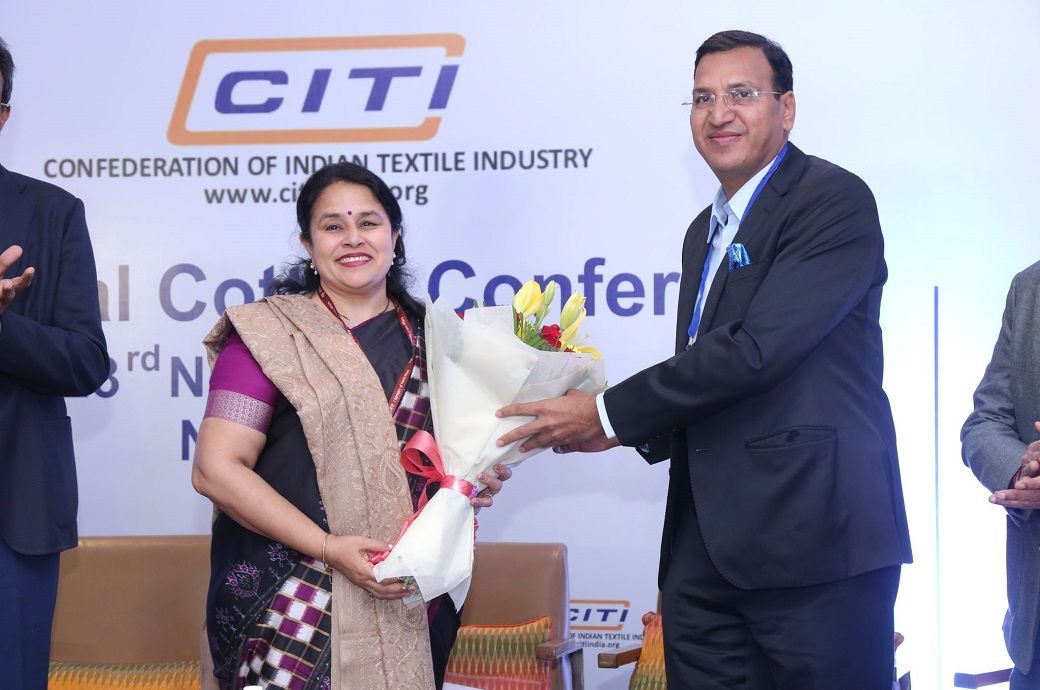
The conference on “Game-changing Technologies & Traits For Achieving High Yields And Fine Quality Of Cotton”, was organised by the Confederation of Indian Textile Industry (CITI).
Speaking at the event, Verma said that the ministries of textiles and agriculture have come together to improve quality and sustainability of cotton production. Cotton acreage increased by seven per cent as an immediate result of the collaboration between the two ministries, she said.
She also highlighted an area where joint efforts will be focused. There will be live data collection, which is most important for strategic planning to tackle any challenge. She also appreciated efforts of the industry for improvement in cotton production. She informed that the Southern India Mills’ Association (SIMA) has distributed handheld machine for cotton ball plucking to around 75,000 farmers of South India.
There was common voice of commitment from all stakeholders of the textile industry to tackle the challenges in cotton production.
Suresh Kotak, chairman of the Textile Advisory Group (TAG), addressed the conference from the perspective of cotton’s present and future. He highlighted that merely productivity enhancement and quality improvement are not enough, and footprint on environment, traceability and circularity are also important issues. He also briefed about activities of TAG, which was formed by the Central government to know the perception of business and industry community.
Textile Commissioner Roop Rashi said that today sustainability and circularity are more important than the earlier time. Textile industry needs to not only limit its impact on the environment but also cut down its cost of production as it can recycle the materials used in the value chain.
Manish Daga, president, All India Cotton Farm Producers’ Organisation, said that Operation White Gold should be launched through farm producers’ organisations (FPOs). It can improve cotton production, yield, and quality. FPO’s of different levels can be engaged for various activities.
Dr. Keshav Kranti, chief scientist with the US-based International Cotton Advisory committee (ICAC) addressed the conference virtually. He said that India should focus on developing brand for traceability and quality assurance. He said that currently the entire world cotton is under pressure due to excessive rain, drought and abnormal temperature.
Dr. YG Prasad, director, ICAR-Central Institute for Cotton Research (CICR) spoken on HTBT cotton and Gryphosate pesticide. He informed that HTBT cotton is yet to be released commercially.
Alexandre Schenkel, vice president, Brazilian Cotton Growers Association (ABRAPA) said that Brazilian cotton yield reduced to the lowest since 2017 due to drought. It touched 0.5 MT per hectare. Many steps have been taken for improvement in cotton production in Brazil.
Dr. Terry Townsend, global consultant of the US-based Cotton Analytics, said that many countries have been developing their own brand to give identity, which are traceability initiatives. India too needs to move fast in that direction.
Vinay Kotak. additional vice president, Cotton Association of India (CAI) remarked on current scenario of domestic cotton. He estimated cotton production to be around 350 bales of 170 kg in current season 2022-23, which will be little better than last year. But this year, the textile value chain is facing poor demand since May 2022.
ALCHEMPro News Desk (KUL)
Receive daily prices and market insights straight to your inbox. Subscribe to AlchemPro Weekly!